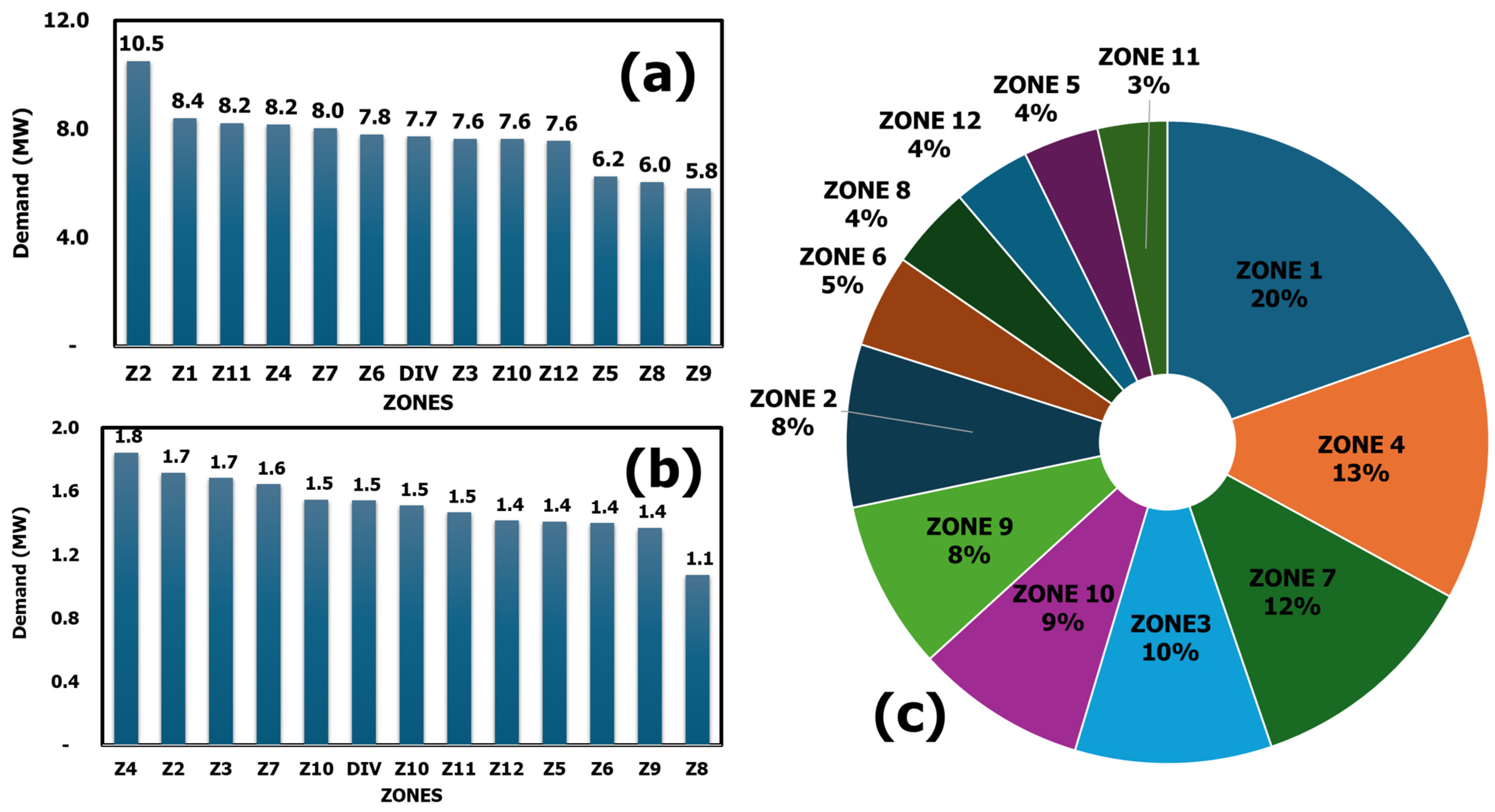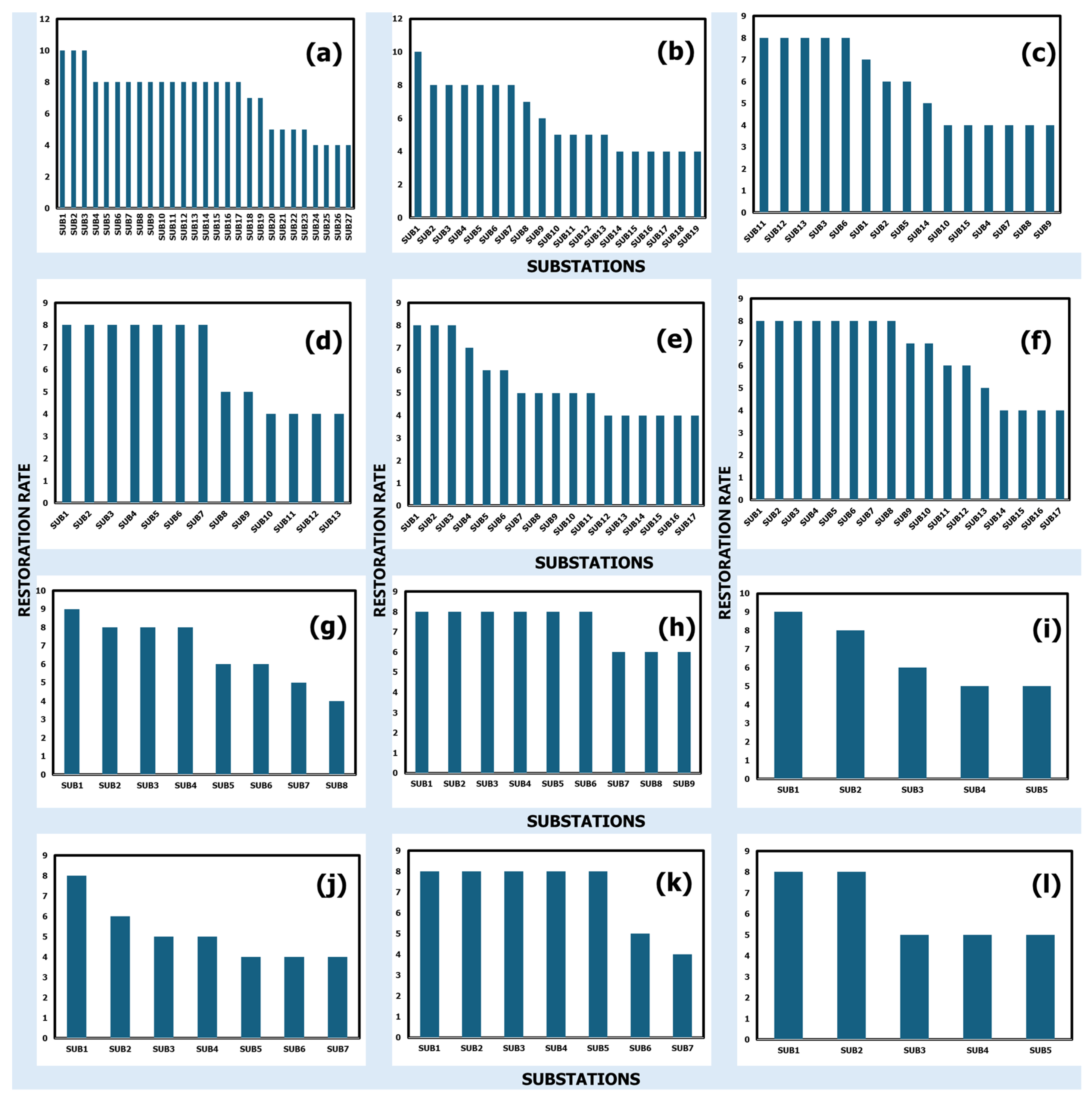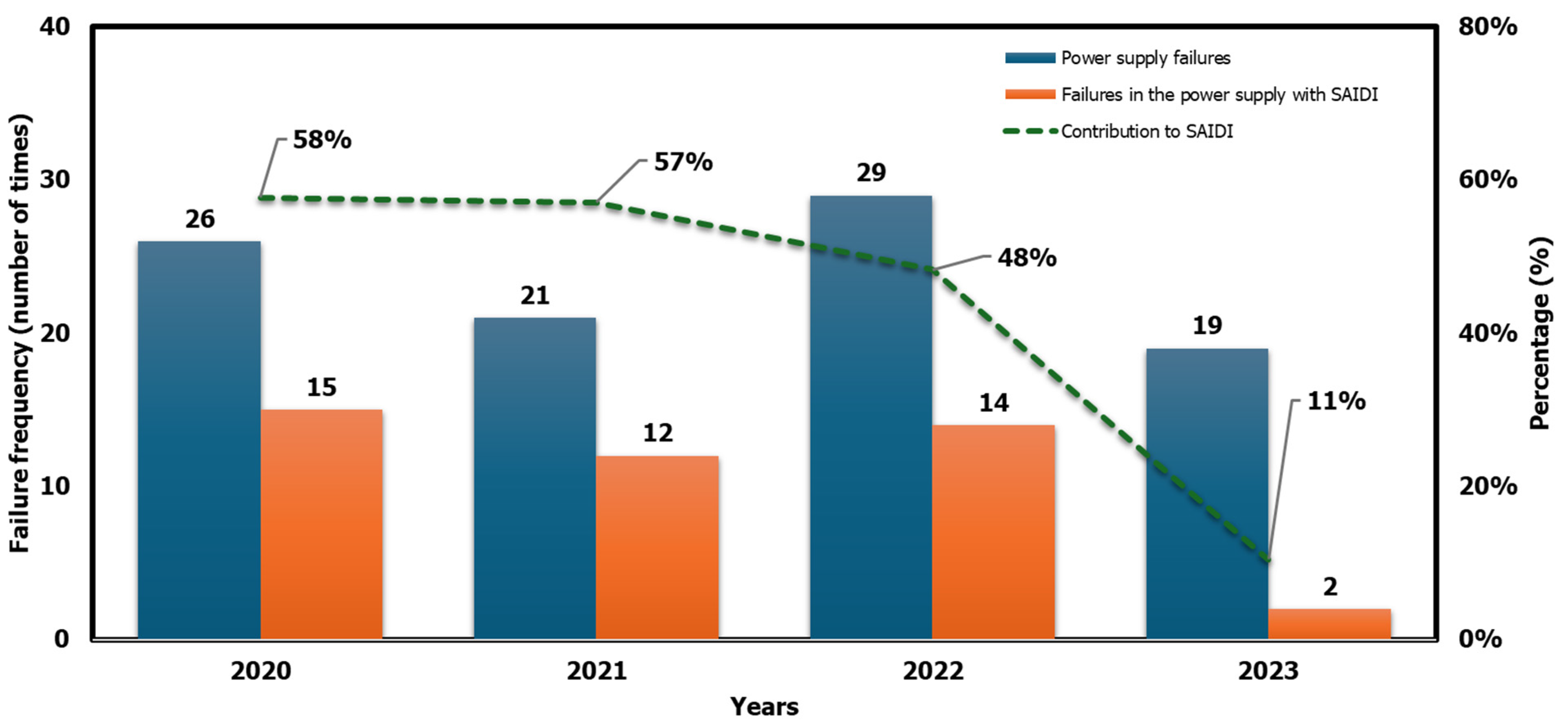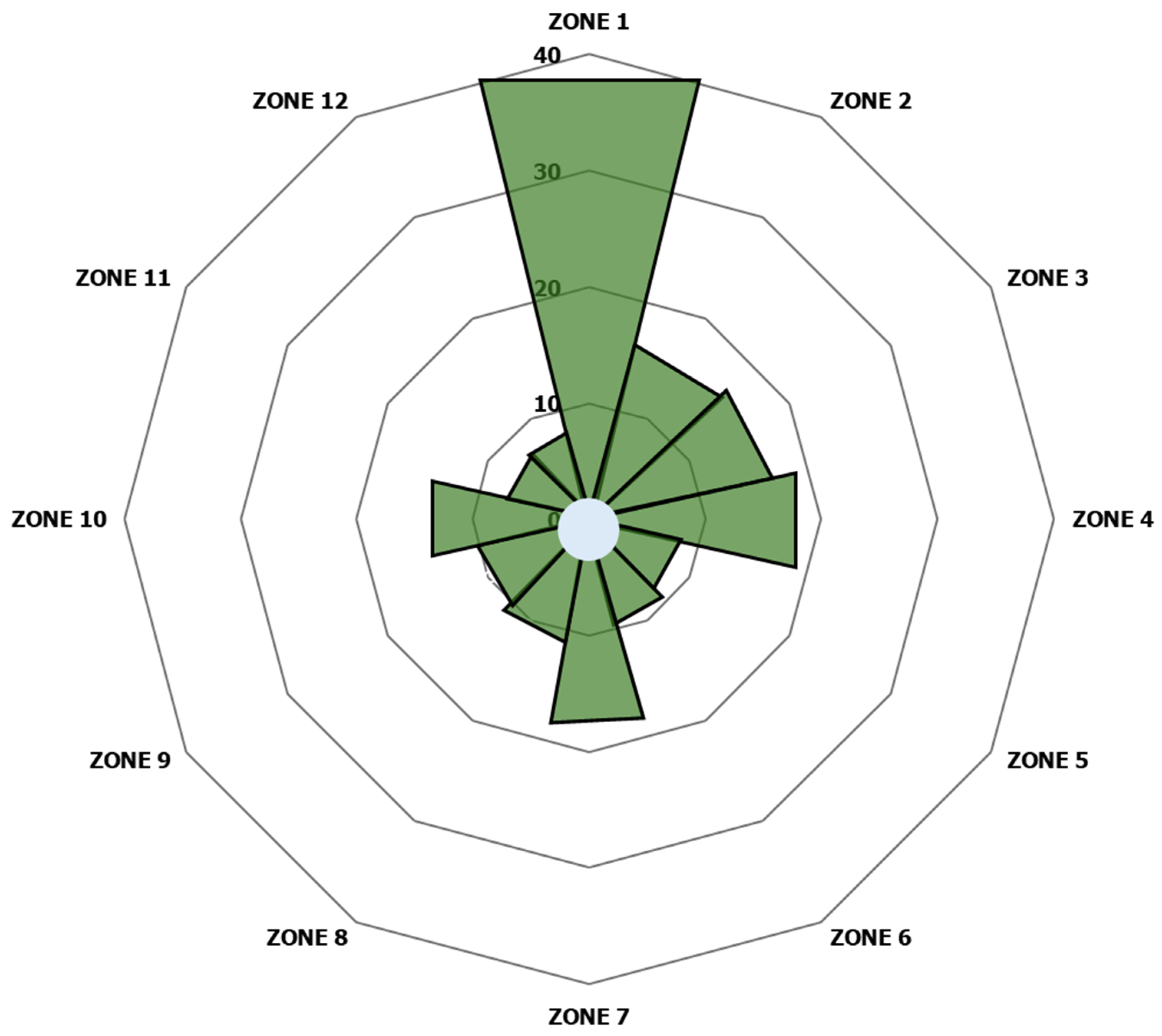Analysis of the Restoration of Distribution Substations: A Case Study of the Central–Western Division of Mexico
Abstract
:1. Introduction
2. Methodology
- (a)
- A comprehensive assessment of the existing infrastructure in the central–western division was performed. This included using the FEC inventory to identify all substations, transformers, and circuits within the CWD. Distribution zones were also established, with data collected on the number of users in each zone and their respective energy requirements.
- (b)
- To estimate restoration times for faults occurring in the substations of the general distribution networks (GDN), two primary scenarios were considered:
- Scenario 1: Restoration time following a primary protection operation failure, which makes the power transformer unavailable until it undergoes inspection for faults (transformer failure).
- Scenario 2: Restoration time in the event of a bus failure during the operation of the power transformer’s low-side switch, causing the low-side bus to become unavailable (distribution bus failure). In this scenario, minimizing downtime and promptly restoring service is crucial.
- TNC: This variable considers the number of circuits connected to the power transformer and determines the baseline time required for remote-control testing maneuvers on the de-energized distribution bus, as well as the analysis of current alarms. This average time is derived from the analysis of substation faults over the past five years, categorized into three types as outlined in Table 1. Each type is visually depicted in Figure 1c.
- TCT: This variable considers the topology of each circuit in the network, including the number and type of connections supporting the affected loads. It also incorporates data on the frequency of substation failures over the past five years to calculate the average time required for operators to perform restoration maneuvers. These maneuvers may involve using remote-controlled equipment or manual disconnection tools with assistance from field staff. As a result, this variable is classified into four categories, as detailed in Table 2.
- -
- CCB: This variable accounts for the number of circuits in the power transformer, categorized into three classes (Table 3).
- -
- TS: This variable considers the topology of the substation within the national transmission network (NTN), as detailed in Table 4.
- -
- RTS: This variable assesses the restoration time of each substation, based on the duration of international indicators like SAIDI, categorized as shown in Table 5.
- (c)
- The RTS and IR parameters were applied to all identified substations in the CWD. The data were analyzed and categorized into three groups: substations with transformers experiencing persistent faults, substations where maneuver enhancements were implemented, and substations identified with significant opportunities for integrating remote-controlled technologies.
3. Results and Discussion
3.1. Diagnosis of Infrastructure and Demand
3.2. Estimation of Restoration Rate and Time
- 32 CWD substations: These substations frequently experience permanent faults in their distribution lines and require load transfer via medium voltage. They are typically equipped with TAP or radial connection lines.
- 67 CWD substations (IR > 7): These substations must improve their restoration maneuvers to enhance service quality and implement improvement projects to reduce their high restoration index as soon as possible.
- 4 CWD substations: These substations urgently need an analysis to improve their energy supply reliability. Specifically, the implementation of remote linking systems is crucial for achieving more efficient restoration times and rates.
3.3. Concluding Remarks
- Operations handbook: The methodology and management processes outlined in this study can be incorporated into a guidance document aimed at addressing the identified challenges within the FEC framework. This handbook would serve as a repository of procedures based on the proposed improvements. Additionally, establishing a national atlas of restoration times and indices would support the development of a comprehensive national improvement program, organized by division, zone, and substation. This initiative seeks to enhance the overall reliability and efficiency of the electrical distribution network throughout the country.
- Modernization of general distribution networks (GDN): This type of analysis supports improvement plans for enhancing distribution infrastructure by identifying critical needs through priority indices such as substations with the highest IR and the largest number of users. For instance, a simple priority index (PI) could be formulated for each zone with IR values exceeding 8. This index would aggregate the number of substations per zone () and incorporate the percentage of users within the entire division as an absolute value ( + %Zone). The resulting numerical value highlights areas requiring priority attention, with larger values indicating substations serving more users (see Figure 5). The implementation of 145 remote units was carried out according to this structured methodology.
- Improved reliability: An area with adequate infrastructure and stringent maintenance protocols ensures reliable electricity supply conditions for users. Implementing the recommendations from this study could greatly improve the reliability of transmission networks across any region.
- Evaluation and simulator: The FEC operates a simulator that models the functions and components of the entire national electrical system. This simulator plays a crucial role in the ongoing training and skill enhancement of both current and new personnel, and supporting their career development and advancement. This simulator could optimize the management of processes during periods of restoration and could be expanded to incorporate new areas, such as algorithms and data processing for all departments across Mexico. This expansion would include training scenarios aimed at managing supply failures in various regions, substations, and power transformers nationwide. Additionally, it could integrate tools for analyzing the economic and environmental impacts of restoration times, aligning with international standards for the quality of electrical energy services.
4. Conclusions
Supplementary Materials
Author Contributions
Funding
Data Availability Statement
Acknowledgments
Conflicts of Interest
References
- Amadei, F.; Valigi, E.; D’Adamo, C. Enel’s Way to SAIDI. Available online: https://www.semanticscholar.org/paper/ENEL%E2%80%99S-WAY-TO-SAIDI-Amadei-Valigi/9be0241b2af1f1dea330136833d24c2212d44e20 (accessed on 12 May 2024).
- Priyanto, Y.T.K.; Otong, M.; Safarudin, Y.M. Analisis Indeks Saidi, Saifi, Caidi Dan Non-Delivery Energy Sistem Distribusi 20 Kv Pada Pt. Pln (Persero) Area Balikpapan Penyulang J2. In Proceedings of the Seminar Nasional NCIET, Semarang, Indonsia, 20 December 2020; Volume 1, pp. 415–422. [Google Scholar] [CrossRef]
- Jamshid, S.; Abrar, M. Evaluation of Load Point and Customer Point Indices of a Distribution Generation System. In Proceedings of the 2nd International Youth Conference on Radio Electronics, Electrical and Power Engineering, REEPE, Moscow, Russia, 12–14 March 2020; pp. 2–6. [Google Scholar] [CrossRef]
- Short, T. Reliability Indices Measurement. EPRI-PEAC 2002, pp. 1–12. Available online: http://resume.marcbrands.com/classfolder/45-859/https@blackboard.andrew.cmu.edu/courses/1/s04-45859/content/_184617_1/tom_short_epri_reliability_indices_2002.pdf (accessed on 10 June 2024).
- Short, T.A. Electric Power Distribution Handbook; CRC Press: Boca Raton, FL, USA, 2004; pp. 108–175. [Google Scholar]
- Paci, A.R.B. Distribution System Reliability Indices Case Study Albanian Distribution System. J. Multidiscip. Eng. Sci. Technol. 2018, 5, 9137–9143. [Google Scholar]
- IEEE Std 1366; IEEE Guide for Electric Power Distribution Reliability Indices. IEEE: Piscataway, NJ, USA, 2012. [CrossRef]
- NERC. 2011 Long-Term Reliability Assessment. Rep NERC 2011. Available online: https://www.nerc.com/pa/RAPA/ra/Reliability%20Assessments%20DL/2011%20LTRA_Final.pdf (accessed on 1 June 2024).
- US Department of Energy. An Assessment of Energy Technologies and Research Opportunities; (Increasing Efficiency of Building Systems and Technologies); Quadrennial Technology Review; US Department of Energy: Washington, DC, USA, 2015; Volume 38.
- U.S. Energy Information Administration. U.S. Power Customers Experienced an Average of Nearly Five Hours of Interruptions in 2019 n.d. Available online: https://www.eia.gov (accessed on 1 August 2024).
- Balabanyan, A.; Semikolenova, Y.; Singh, A.; Lee, M.A. Utility Performance and Behavior in Africa Today; World Bank Group: Washington, DC, USA, 2021. [Google Scholar] [CrossRef]
- Council of European Energy Regulators, Energy Community Regulatory Board. 7th Benchmarking Report on the Quality of Electricity and Gas Supply. 2022. Available online: https://www.energy-community.org/dam/jcr:532272db-5b1e-4cf4-b12e-7ed59933ba42/CEER_ECRB_Benchmarking%20Report_2022.pdf (accessed on 1 June 2024).
- Weiss, M.; Ravillard, P.; Sanin, M.E.; Carvajal, F.; Daltro, Y.; Chueca, E.; Hallack, M.C.M. Impact of Regulation on the Quality of Electric Power Distribution Services in Latin America and the Caribbean; Technical Note No IDB-TN-2328; Inter-American Development Bank, Energy Division: Washington, DC, USA, 2021. [Google Scholar]
- Prettico, G.; Marinopoulos, A.; Vitiello, S. Guiding electricity distribution system investments to improve service quality: A European study. Util. Policy 2022, 77, 101381. [Google Scholar] [CrossRef]
- Janiszewski, P.; Sawicki, J.; Kurpas, J.; Mróz, M. Practical Ways to Improve SAIDI and SAIFI Power Supply Reliability Indicators in an MV Grid. Acta Energ. 2018, 34, 45–50. [Google Scholar] [CrossRef]
- Heylen, E.; Deconinck, G.; Van Hertem, D. Review and classification of reliability indicators for power systems with a high share of renewable energy sources. Renew. Sustain. Energy Rev. 2018, 97, 554–568. [Google Scholar] [CrossRef]
- Pansini, A. Guide to Electrical Power Distribution Systems; The Fairmont Press: Lilburn, GA, USA, 2005; pp. 4–35. [Google Scholar]
- Patrick, D.R.; Fardo, S.W. Electrical Power Systems Technology; The Fairmont Press: Lilburn, GA, USA, 2009; pp. 203–2055. [Google Scholar]
- Tenbohlen, S.; Coenen, S.; Djamali, M.; Müller, A.; Samimi, M.H.; Siegel, M. Diagnostic measurements for power transformers. Energies 2016, 9, 347. [Google Scholar] [CrossRef]
- López, J.C.; Franco, J.F.; Rider, M.J. Optimisation-based switch allocation to improve energy losses and service restoration in radial electrical distribution systems. IET Gener. Transm. Distrib. 2016, 10, 2792–2801. [Google Scholar] [CrossRef]
- Van Hentenryck, P.; Coffrin, C. Transmission system repair and restoration. Math. Program. 2015, 151, 347–373. [Google Scholar] [CrossRef]
- Abniki, H.; Taghvaei, S.M.; Mohammadi-Hosseininejad, S.M. Reliability improvement in smart grid through incorporating energy storage systems in service restoration. Int. Trans. Electr. Energy Syst. 2019, 29, 1–18. [Google Scholar] [CrossRef]
- Aguero, J.R.; Spare, J.; Phillips, E.; O’Meally, C.; Wang, J.; Brown, R.E. Distribution system reliability improvement using predictive models. In Proceedings of the 2009 IEEE Power & Energy Society General Meeting, Calgary, AB, Canada, 26–30 July 2009; pp. 1–7. [Google Scholar] [CrossRef]
- Jamborsalamati, P.; Hossain, M.J.; Taghizadeh, S.; Konstantinou, G.; Manbachi, M.; Dehghanian, P. Enhancing Power Grid Resilience through an IEC61850-Based EV-Assisted Load Restoration. IEEE Trans. Ind. Inform. 2020, 16, 1799–1810. [Google Scholar] [CrossRef]
- Shen, F.; Wu, Q.; Xue, Y. Review of Service Restoration for Distribution Networks. J. Mod. Power Syst. Clean. Energy 2020, 8, 1–14. [Google Scholar] [CrossRef]
- Ćurčić, S.; Özveren, C.S.; Crowe, L.; Lo, P.K.L. Electric power distribution network restoration: A survey of papers and a review of the restoration problem. Electr. Power Syst. Res. 1995, 35, 73–86. [Google Scholar] [CrossRef]
- Huang, W.; Shao, C.; Hu, B.; Li, W.; Sun, Y.; Xie, K.; Zio, E.; Li, W. A restoration-clustering-decomposition learning framework for aging-related failure rate estimation of distribution transformers. Reliab. Eng. Syst. Saf. 2023, 232, 109043. [Google Scholar] [CrossRef]
- Xie, K.; Li, W. Analytical model for unavailability due to aging failures in power systems. Int. J. Electr. Power Energy Syst. 2009, 31, 345–350. [Google Scholar] [CrossRef]
- Wang, R.; Xue, A.; Huang, S.; Cao, X.; Shao, Z.; Luo, Y. On the estimation of time-varying failure rate to the protection devices based on failure pattern. In Proceedings of the 2011 4th International Conference on Electric Utility Deregulation and Restructuring and Power Technologies (DRPT), Weihai, China, 6–9 July 2011; pp. 902–905. [Google Scholar] [CrossRef]
- Zhou, D.; Wang, Z.; Li, C. Data requisites for transformer statistical lifetime modelling-part I: Aging-related failures. IEEE Trans. Power Deliv. 2013, 28, 1750–1757. [Google Scholar] [CrossRef]
- Xu, Y.; Liu, C.C.; Gao, H. Reliability analysis of distribution systems considering service restoration. In Proceedings of the 2015 IEEE Power & Energy Society Innovative Smart Grid Technologies Conference, Washington, DC, USA, 18–20 February 2015; pp. 1–5. [Google Scholar] [CrossRef]
- Shen, F.; Wu, Q.; Huang, S.; Lopez, J.C.; Li, C.; Zhou, B. Review of Service Restoration Methods in Distribution Networks. In Proceedings of the 2018 IEEE PES Innovative Smart Grid Technologies Conference Europe (ISGT-Europe), Sarajevo, Bosnia and Herzegovina, 21–25 October 2018. [Google Scholar] [CrossRef]
- Chiaradonna, S.; Di Giandomenico, F.; Masetti, G. Analyzing the impact of failures in the electric power distribution grid. In Proceedings of the 2016 Seventh Latin-American Symposium on Dependable Computing (LADC), Cali, Colombia, 19–21 October 2016; pp. 99–108. [Google Scholar] [CrossRef]
- Liu, H.; Davidson, R.A.; Apanasovich, T.V. Statistical forecasting of electric power restoration times in hurricanes and ice storms. IEEE Trans. Power Syst. 2007, 22, 2270–2279. [Google Scholar] [CrossRef]
- Duffey, R.B.; Ha, T. The probability and timing of power system restoration. IEEE Trans. Power Syst. 2013, 28, 3–9. [Google Scholar] [CrossRef]
- Vinogradov, A.; Bolshev, V.; Vinogradova, A.; Jasiński, M.; Sikorski, T.; Leonowicz, Z.; Goňo, R.; Jasińska, E. Analysis of the power supply restoration time after failures in power transmission lines. Energies 2020, 13, 2736. [Google Scholar] [CrossRef]
- Liu, Y.; Fan, R.; Terzija, V. Power system restoration: A literature review from 2006 to 2016. J. Mod. Power Syst. Clean Energy 2016, 4, 332–341. [Google Scholar] [CrossRef]
- Navarro-Chávez, C.L.; Delfín-Ortega, O.V.; Díaz-Pulido, A. Efficiency of the electricity sector in Mexico 2008–2015: An application of the DEA network model. Int. J. Energy Sect. Manag. 2020, 14, 683–706. [Google Scholar] [CrossRef]
- López, J.C.; Lavorato, M.; Rider, M.J. Optimal reconfiguration of electrical distribution systems considering reliability indices improvement. Int. J. Electr. Power Energy Syst. 2016, 78, 837–845. [Google Scholar] [CrossRef]
- Sperr, F.; Stai, E.; Venkatraman, A.; Krause, T.; Hug, G. Service Restoration in the Medium Voltage Grid Minimizing the SAIDI Contribution After Primary Substation Failures. IEEE Trans. Power Syst. 2024, 39, 66–82. [Google Scholar] [CrossRef]
- Chaitra, A.S.; Sudarshana Reddy, H.R. Improving Reliability in Distribution Systems through Optimal Allocation of Distributed Generators, Network Reconfiguration and Capacitor Placement. SN Comput. SCI 2024, 5, 1–12. [Google Scholar] [CrossRef]
- Alves, P.; Basílio, J.; Jorge, R.D.; Aleixo, A.C.; Paulo, R.D.; Blanquet, A.; Espírito Santo, B. Advanced Decentralized Protection, Control and Monitoring Strategies For Distribution Automation. In Proceedings of the 25th International Conference on Electricity Distribution, Madrid, Spain, 3–6 June 2019; Volume 1138, pp. 3–6. [Google Scholar]
- Zharkin, A.; Novskyi, V.; Popov, V.; Palachov, S. Improving the Reliability and Power Quality in Distribution Networks with Sources of Dispersed Generation. In Power Systems Research and Operation: Selected Problems; Springer: Cham, Swtizerland, 2022. [Google Scholar] [CrossRef]
- Anteneh, D.; Khan, B.; Mahela, O.P.; Alhelou, H.H.; Guerrero, J.M. Distribution network reliability enhancement and power loss reduction by optimal network reconfiguration. Comput. Electr. Eng. 2021, 96, 107518. [Google Scholar] [CrossRef]
- CRE. Reporte de Confiabilidad del Sistema Eléctrico Nacional. 2022. Available online: https://www.gob.mx/cms/uploads/attachment/file/876900/Anexo_Acuerdo_A-075-2023.pdf (accessed on 3 July 2024).
- SENER. Balance Nacional de Energía. Gob México. 2023. Available online: https://www.gob.mx/sener/articulos/balance-nacional-de-energia-296106 (accessed on 7 July 2024).
- SENER. Demanda y Consumo 2021–2035. Available online: https://www.gob.mx/cms/uploads/attachment/file/649612/PRODESEN_CAP_TULO-4.pdf (accessed on 7 July 2024).
- Dimitrijevic, S.; Rajakovic, N. An innovative approach for solving the restoration problem in distribution networks. Electr. Power Syst. Res. 2011, 81, 1961–1972. [Google Scholar] [CrossRef]
- Xie, S.; Wang, X.; Qu, C.; Wang, X.; Guo, J. Impacts of different wind speed simulation methods on conditional reliability indices. Int. Trans. Electr. Energy Syst. 2015, 25, 359–373. [Google Scholar] [CrossRef]
- Sampaio, R.F.; Melo, L.S.; Leão, R.P.S.; Barroso, G.C.; Bezerra, J.R. Automatic restoration system for power distribution networks based on multi-agent systems. IET Gener. Transm. Distrib. 2017, 11, 475–484. [Google Scholar] [CrossRef]





| Type | Description |
|---|---|
| A | It is designed for power transformers equipped with 1 to 4 medium voltage circuits, with a designated time frame of 1 min. |
| B | It is designed for power transformers equipped with 5 to 6 medium voltage circuits, with a specified duration of 1.5 min. |
| C | This applies to power transformers with more than six medium voltage circuits, for which a designated time of 2 min per circuit is allocated. |
| Type | Description | Diagram |
|---|---|---|
| A | It is assumed that the circuit includes at least one remote-controlled connection with a circuit from another substation, with a defined time of 0.5 min allocated for this maneuver. |  |
| B | It is assumed that the circuit is equipped with at least one remote connection to another circuit within the same substation, with a designated time of 0.75 min allocated for this operation. |  |
| C | It is assumed that the restoration of circuit load occurs using the low-voltage side bus of the same power transformer, with a specified time of 0.75 min assigned for this maneuver. |  |
| D | It is assumed that the restoration of the circuit load will be achieved through a manual connection with the assistance of field personnel, with a designated time of 30 min allocated for this operation. |  |
| Type | Description | Qualifying |
|---|---|---|
| A | Substations with 1 to 4 medium voltage circuits | 1 |
| B | Substations with 5 to 6 medium voltage circuits | 2 |
| C | Substations with more than 6 medium voltage circuits | 3 |
| Type | Description | Qualifying |
|---|---|---|
| A | Ring substation | 1 |
| R | Radial Substation | 2 |
| T | Substation in TAP | 3 |
| Type | Description | Qualifying | Impact on Indicators |
|---|---|---|---|
| 1 | Recovery time in scenario two < 5 min | 2 | NO |
| 2 | Recovery time in scenario two = 5 min | 3 | NO |
| 3 | Recovery time in scenario two > 5 min | 4 | YES |
| Zone | Clue | Substations (SUB) | Transformers Power | Circuits | Circuits Average per Bank | Users | % USU DIV | USU/Bank | USU/CTO | Demand (DEM) MW | % DEM Division | DEM/Bank | DEM/CTO |
|---|---|---|---|---|---|---|---|---|---|---|---|---|---|
| Zone 1 | Z1 | 21 | 27 | 150 | 6 | 513,258 | 20.5% | 19,010 | 3422 | 226.5 | 19.6% | 8.4 | 1.5 |
| Zone 2 | Z2 | 7 | 9 | 55 | 6 | 219,673 | 8.8% | 24,408 | 3994 | 94.5 | 8.2% | 10.5 | 1.7 |
| Zone 3 | Z3 | 12 | 15 | 68 | 5 | 254,954 | 10.2% | 16,997 | 3749 | 114.5 | 9.9% | 7.6 | 1.7 |
| Zone 4 | Z4 | 15 | 19 | 84 | 4 | 271,904 | 10.9% | 14,311 | 3237 | 155.0 | 13.4% | 8.2 | 1.8 |
| Zone 5 | Z5 | 6 | 7 | 31 | 4 | 163,214 | 6.5% | 23,316 | 5265 | 43.7 | 3.8% | 6.2 | 1.4 |
| Zone 6 | Z6 | 5 | 7 | 39 | 6 | 105,724 | 4.2% | 15,103 | 2711 | 54.6 | 4.7% | 7.8 | 1.4 |
| Zone 7 | Z7 | 14 | 17 | 83 | 5 | 225,091 | 9.0% | 13,241 | 2712 | 136.5 | 11.8% | 8.0 | 1.6 |
| Zone 8 | Z8 | 8 | 8 | 45 | 6 | 163,785 | 6.5% | 20,473 | 3640 | 48.3 | 4.2% | 6.0 | 1.1 |
| Zone 9 | Z9 | 14 | 17 | 72 | 4 | 168,529 | 6.7% | 9913 | 2341 | 98.7 | 8.5% | 5.8 | 1.4 |
| Zone 10 | Z10 | 10 | 13 | 64 | 5 | 162,872 | 6.5% | 12,529 | 2545 | 99.1 | 8.6% | 7.6 | 1.5 |
| Zone 11 | Z11 | 4 | 5 | 28 | 6 | 128,210 | 5.1% | 25,642 | 4579 | 41.1 | 3.5% | 8.2 | 1.5 |
| Zone 12 | Z12 | 4 | 6 | 32 | 5 | 128,271 | 5.1% | 21,379 | 4008 | 45.3 | 3.9% | 7.6 | 1.4 |
| Totals | 120 | 150 | 751 | 5 | 2,505,485 | 100% | 16,703 | 3336 | 1157.6 | 100% | 7.7 | 1.5 | |
| Topology | Number of Circuits | TPR/Substation (min) | Restoration Index | ||||||||||||
|---|---|---|---|---|---|---|---|---|---|---|---|---|---|---|---|
| Zone | Clue | SUB | Transformers Power | A | R | T | A | B | C | Scenario 1 | Scenario 2 | 1 to 4 | 5 to 7 | 8 to 9 | 10 |
| Zone 1 | Z1 | 21 | 27 | 15 | 1 | 5 | 5 | 5 | 17 | 5.0 | 38.6 | 4 | 6 | 14 | 3 |
| Zone 2 | Z2 | 7 | 9 | 4 | 1 | 2 | 2 | 1 | 6 | 5.3 | 24.8 | 0 | 3 | 6 | 0 |
| Zone 3 | Z3 | 12 | 15 | 10 | 0 | 2 | 8 | 1 | 6 | 4.0 | 13.7 | 6 | 4 | 5 | 0 |
| Zone 4 | Z4 | 15 | 19 | 11 | 2 | 2 | 8 | 4 | 7 | 4.1 | 19.5 | 6 | 6 | 6 | 1 |
| Zone 5 | Z5 | 6 | 7 | 5 | 0 | 1 | 4 | 2 | 1 | 3.9 | 3.9 | 3 | 3 | 1 | 0 |
| Zone 6 | Z6 | 5 | 7 | 4 | 1 | 0 | 2 | 0 | 5 | 5.3 | 26.2 | 1 | 1 | 5 | 0 |
| Zone 7 | Z7 | 14 | 17 | 10 | 0 | 3 | 6 | 2 | 9 | 4.3 | 18.1 | 4 | 5 | 8 | 0 |
| Zone 8 | Z8 | 8 | 8 | 5 | 1 | 2 | 3 | 1 | 4 | 4.8 | 8.5 | 1 | 3 | 4 | 0 |
| Zone 9 | Z9 | 14 | 17 | 9 | 5 | 0 | 10 | 2 | 5 | 3.8 | 14.1 | 6 | 8 | 3 | 0 |
| Zone 10 | Z10 | 10 | 13 | 8 | 2 | 0 | 6 | 0 | 7 | 4.7 | 40.7 | 4 | 2 | 7 | 0 |
| Zone 11 | Z11 | 4 | 5 | 2 | 1 | 1 | 1 | 2 | 2 | 5.2 | 5.2 | 0 | 3 | 2 | 0 |
| Zone 12 | Z12 | 4 | 5 | 5 | 0 | 0 | 1 | 3 | 2 | 4.8 | 4.8 | 1 | 3 | 2 | 0 |
| Division | 120 | 150 | 88 | 14 | 18 | 56 | 23 | 71 | 4.6 | 18.2 | 36 | 47 | 63 | 4 | |
| Total | 120 | 150 | 67 | ||||||||||||
Disclaimer/Publisher’s Note: The statements, opinions and data contained in all publications are solely those of the individual author(s) and contributor(s) and not of MDPI and/or the editor(s). MDPI and/or the editor(s) disclaim responsibility for any injury to people or property resulting from any ideas, methods, instructions or products referred to in the content. |
© 2024 by the authors. Licensee MDPI, Basel, Switzerland. This article is an open access article distributed under the terms and conditions of the Creative Commons Attribution (CC BY) license (https://creativecommons.org/licenses/by/4.0/).
Share and Cite
Sánchez-Ixta, C.; Vázquez-Abarca, J.R.; López-Sosa, L.B.; Golpour, I. Analysis of the Restoration of Distribution Substations: A Case Study of the Central–Western Division of Mexico. Energies 2024, 17, 4154. https://doi.org/10.3390/en17164154
Sánchez-Ixta C, Vázquez-Abarca JR, López-Sosa LB, Golpour I. Analysis of the Restoration of Distribution Substations: A Case Study of the Central–Western Division of Mexico. Energies. 2024; 17(16):4154. https://doi.org/10.3390/en17164154
Chicago/Turabian StyleSánchez-Ixta, Carlos, Juan Rodrigo Vázquez-Abarca, Luis Bernardo López-Sosa, and Iman Golpour. 2024. "Analysis of the Restoration of Distribution Substations: A Case Study of the Central–Western Division of Mexico" Energies 17, no. 16: 4154. https://doi.org/10.3390/en17164154
APA StyleSánchez-Ixta, C., Vázquez-Abarca, J. R., López-Sosa, L. B., & Golpour, I. (2024). Analysis of the Restoration of Distribution Substations: A Case Study of the Central–Western Division of Mexico. Energies, 17(16), 4154. https://doi.org/10.3390/en17164154







